One of TrailsWA's Top Trails, the Railway Reserves Heritage Trail's main loop provides a 41 kilometre walk or cycle through the Perth Hills. Starting at multiple points, the trail interprets the rail heritage of the area through public art and even playgrounds with a railway theme. Passing through lovely bushland and the waterfalls of John Forrest National Park, this is a lovely cycling loop that is at its best in late Winter/early Spring
Distance: 41 km (loop)
Gradient: Mostly gentle with some moderate climbs and descents. General uphill trend from Swan View and then a downhill trend from Mundaring
Quality of Path: almost entirely on gravel rail trail
Quality of Signage: Mostly well signed at all trail junctions
Experience Required: Mountain Biking experience recommended, good stamina required if walking the trail
Time: 3-6 Hours on a bike, including lunch. 10-12 hours on foot
Steps: None, this is a dual use trail
Best Time to Visit: All Year, but is at its best in late Winter/early Spring
Date(s) Completed: 2nd August, 2020
Best Time to Visit: All Year, but is at its best in late Winter/early Spring
Date(s) Completed: 2nd August, 2020
Entry Fee: No, unless accessing the trail from the picnic area in John Forrest National Park
Getting There: Access points are located at numerous points along the trail, but the best starting point is the Swan View Trailhead. From Roe Hwy, turn east onto Morrison Rd (north of Great Eastern Hwy) and take it to the roundabout at Pechey Rd/Swan Rd. Turn either left or right to park at one of the main car parks; the lower one to the right is preferable given it is closer to the trailhead
Getting There: Access points are located at numerous points along the trail, but the best starting point is the Swan View Trailhead. From Roe Hwy, turn east onto Morrison Rd (north of Great Eastern Hwy) and take it to the roundabout at Pechey Rd/Swan Rd. Turn either left or right to park at one of the main car parks; the lower one to the right is preferable given it is closer to the trailhead
Something I've been asked on more than one occasion is why I've never included the Railway Reserves Heritage Trail on The Long Way's Better in spite of it being a popular Top Trail. It was certainly not for lack of having done it; I did the main loop for the first time with a friend in 2010, another time by myself and once solo but also doing the return leg section to Wooroloo. This was back in the day when distance was the main motivation for my hiking, however now that I'm much more driven by aesthetics, I have not had the interest in walking the whole loop for a fourth time.
That being said, Alissa and I had ridden the trail on many occasions in the intervening years. When the first COVID-19 lockdowns in 2020 saw us limited to the Perth and Peel regions and my job had me on reduced hours with Mondays off, Alissa and I did the loop twice in April. It was in a lot of ways be the precursor to me starting a Munda Biddi sectional End to End, and I decided that I would finally add it to the blog - but as a cycle trail. Waiting for Winter to capture the trail at its best, Alissa and I headed back out to the hills for our third go at the loop for 2020.
The trail features many trailheads and can be started from any of them. My strong advice is to start the trail at the Swan View trailhead at the corner of Morrison and Swan Rds and head in a counter-clockwise direction. The reason for this is that it represents the best trail experience; you get all the ascents and the less impressive looking parts of the trail done early and then get a mostly downhill run from the Mundaring Sculpture Park all the way through John Forrest National Park and back to the car park.
Heading counter-clockwise from Swan View, the trail allows riders to ease into the experience as it heads in a generally downhill direction to start with. The old railway line has long been removed and replaced by a fairly well compacted gravel trail. Munda Biddi riders who have ridden the notoriously loose pea gravel of the trail north of Dwellingup will find this pretty easy and smooth to ride, however for those who are used to pavement the slightly looser nature of the gravel may come as a surprise. This was the case for Alissa who found the riding a bit disconcerting on her first ride and again in August as it had been a long time between rides. For me, having crashed three times on the Munda Biddi by this stage due to loose pea gravel, this surface seemed like a smooth dream by comparison!
Given that suburbs have sprung up around the rail reserve in the intervening years, the Heritage Trail crosses a number of roads as it makes its way along the loop. Almost all of these feature signage that identify the road, with kilometre information to the next major intersections and trailheads. These are great, user friendly features for first time or casual riders as they allow you to judge how fast you've been travelling. From a hikers' point of view this is even more important given 40 kilometres is quite a significant distance on foot and it is nice to get regular updates on your progress.
The next trailhead along is located in Greenmount and marks the beginning of the only section of the trail that runs along suburban streets. To me, it looks like it would be possible to create a gravel trail along the road, however given the quiet nature of the suburbs through here the road riding along Buninyong Rd is perfectly fine if not overly exciting.
Just before reaching Great Eastern Hwy, the Heritage Trail joins onto a section of dual use trail as it crosses under the highway. This dual use section is relatively short and only covers the bend under the bridge given it is a bit of a blind corner that would be dangerous for cyclists to share with drivers.
After another 400 metres on the road, the Munda Biddi returns to gravel trail once again at the Bellevue Trailhead. This is the start of the uphill section of the trail, and Alissa and I have often said this would be an acceptable alternative starting point for the loop if the Swan View car park was completely full, as it would basically be all downhill to Bellevue once you've completed the ascent.
A cool feature of the trail is that a lot of thought has gone into both maximising the use of the rail reserve as parkland while also ensuring it engages with its past. While even greater examples can be found further along the trail, the Railway crossing gate that frames the playground at Bellevue is a simple illustration of how they have even themed the playgrounds to engage with the area's heritage.
It is not just the playgrounds that engage with the area's heritage; several sculptural artworks can be found along the trail at key sites, such as the remains of the old railway station at Koongamia. The artwork by Stuart Green is arguably one of the trail's most iconic, with the sculptures creating a line while representing a series of destinations as if along a railway line.
After the station, it is basically a long slow uphill climb all the way through to Mundaring. This is the point where Alissa starts to hate the trail as it is about 15 kilometres with only brief respites from the climbing. It is not particularly hard, but for inexperienced cyclists the 15 kilometres can feel like a somewhat taxing eternity, particularly if it is your first ride and you've not experienced the downhill payoff.
What few dips that do exist provide a respite from the climbing, and I definitely feel like they are worth embracing. Through this section of the ride, a much more extensive section of forest to the left of the trail helps make it feel less like the narrow strip of vegetation that it had been up to this point. Something that I had never really cottoned onto until very recently is that this is where the Goat Farm Mountain Bike Park is located, which now makes sense of the higher number of mountain bikers that I've seen through this section.
A more obvious side trip off the trail is Mountain Quarry. Also known as Boya Quarry, the area is one of the most popular rock climbing areas in the Perth Hills and can be very busy over a fine weekend. While I'm not a rock climber, I always feel like the side trip into the quarry is well worth taking.
Leaving Mountain Quarry, the trail crosses Coulston Rd and again enters a narrower section of forested rail reserve.
While narrow, there is a greater lushness through this area that makes it feel like a step up from the more suburban feel of the trail closer to Bellevue. More dubiously, from here through to Glen Forrest is a section of the trail when I've been swooped by magpies in the past, and though there were no such incidents in the three times Alissa and I rode the trail in 2020, it is something I'm on high alert for whenever we enter this section.
After Swan View Station, Darlington Station is probably one of the stations in best condition, and features a platform of quite a substantial length. While the structures of the station have long since been dismantled, signage indicates where the various building used to be located back in its glory days.
Beyond Darlington, the rail trail runs along a section of form that is built up higher that the surrounding area.
Overlooking Binbrook Park and Glen Forrest Superblock, this stretch provides some of the nicest forest views along the loop before reaching the similarly raise section of trail that can be seen in John Forrest National Park.
Another highlight of this part of the trail is the creek system that runs alongside, and features a small waterfall. This is another example of why the trails in Perth are truly at the best in late Winter/early Spring - something that becomes even more important further along the route.
The Glen Forrest trailhead marks the end of the forest and creek views as the Railway Reserves Heritage Trail enters some grassed parkland where the Glen Forrest station used to be.
The park in Glen Forrest features one of the trail's most iconic features - Train Park. Dominated by a large train-themed playground, this park can be very popular on fine weekends in Autumn and Springtime.
Leaving Glen Forrest, the trail leaves the built up suburban areas surround Train Park as it reenters more forest-dominated scenery. Through here, the trail passes Statham Wetland, which is both a prominent landmark along the trail due to its quite unique appearance but also due to the fact its name always makes me wish someone would 'correct' the sign by changing it to read 'Jason Statham Wetland'.
Jason Statham Wetland to me marks the home stretch to Mundaring, and as I was eager to get to Mundaring as soon as possible Alissa and I decided that I would push on at my pace and wait for her in the Sculpture Park. While I speeding along the trail, I had to stop for a second to appreciate a particularly profuse patch of wildflowers. While I'm not a particularly dedicated wildflower spotter, I do like the overall impression of fields of flowers filling your field of vision, and it is again one of the great pleasures of cycling or hiking in August through to October.
Since Bellevue, the trail had been on a mostly uphill trajectory, however it starts to turn downhill as it runs close to Thomas Rd. While a bit of a boring stretch visually, the fact the trail starts to speed up here always puts a smile on my face as I push on into Mundaring.
With the whole area being under the local government area of the Shire of Mundaring, it is understandable that the most significant park of the trail is around where the former Mundaring Train Station used to be located.
Known as the Mundaring Sculpture Park, the area is filled with public artworks that mostly engage with the railway heritage of the area, such as the signals seen above. Many people start the trail here given its central location, with the ride under the signal flags being the triumphant end to their loop of the Railway Reserves Heritage Trail.
The Mundaring Sculpture Park is also the trailhead for the Munda Biddi Trail. At the time Alissa and I rode the Heritage Trail in early August, I'd had a bit of break from the Munda Biddi after doing a week on the trail from Pemberton to beyond Walpole in early July and was raring to get back into it.
With Alissa finding the trail tougher than she had found it in April, we were a bit behind schedule and decide to have lunch in Mundaring rather than stopping in at Mt Helena Tavern as planned. Mundaring has the greatest variety of dining options, ranging from pub grub at the Mundaring Hotel, a couple of bakeries, several cafes and fast food chains like Subway, McDonald's, Hungry Jack's and KFC.
After lunch, we returned to the Mundaring Sculpture Park to recommence the trail. Leaving the park, the trail passes a junction where the Kep Track and Munda Biddi Trail take a right turn down towards the Mundaring Weir Hotel.
From here the Heritage Trail begins its general downhill trend and makes for fast and fun riding. After riding through an interesting cutting, the trail joins onto an odd section of road that cannot be accessed by car anymore, but clearly used to be an extension of Halifax Place connecting directly to Great Eastern Hwy. I used to love this section due to the novelty of the closed off road and the assortment of tall trees, however in between April and August 2020 this area was completely ruined as most of the larger trees were cut down. What was once a cool oddity is now a hideous eyesore, and I can only hope that they had a legitimate reason for removing the trees.
Beyond the cleared street, the Railway Reserves Heritage Trail crosses Great Eastern Hwy. The crossing thankfully features an island in the median strip, making it safe and easy to cross in spite of being a busy trucking route.
North of Great Eastern Hwy, the Railway Reserve feels wilder and less developed, and with extended sections within cuttings it can really start to feel like you're deep within forest even through sections are just a narrow reserve strip.
At Sawyers Valley, an old information shelter looks to be one of the original trailheads before they were updated. There is another modern Sawyers Valley trailhead nearby that matches the look of the others along the way.
Next to the old shelter is a small wetland within Jarrah Creek Reserve. While small, there are often wetland birds poking around through the area. I remember there was a time when this and other creeks along the trail were being choked by Arum Lillies, but there appears to have been a concerted effort to remove these declared pests from the waterways.
Crossing Sawyers Rd, the Heritage Trail passes the Sawyers Valley Tavern. As a self-professed beer hipster, I always find the juxtaposition of the Art Deco parapet in the front with the large XXXX Gold sign on the roof to be quite amusing given Art Deco is usually associated with luxury and high modernism, and XXXX Gold is a macrobrewery beer that screams 'proletariat' rather than 'bourgeoisie'.
After Sawyers Road is one of my favourite sections of the entire trail. While the descent from Mundaring is gentle to moderate, this features one of the only significantly steep sections of the trail, and I love pedalling hard at the approach to speed down as fast as possible. Less confident on gravel, Alissa tends to take this with a lot more caution as she's much more scared of crashing a bike than I am (in spite of the fact I'm the one who has actually crashed a few times).
While it levels out a few times and crosses a few roads, it is basically fast and fun riding all the way to Mt Helena, with some of the deepest cuttings of the entire trail giving it a really enclosed feeling.
At Mt Helena, the Railways Reserves Heritage Trail reaches a junction. Officially, the trail has an eastern section that extends for 14 kilometres to Wooroloo. I once walked it when I decided to do the entire trail (not recommended), however I think when most people think of the Railway Reserves Heritage Trail they are thinking of the main 41 kilometre loop. The eastern section is also entirely part of the Kep Track, and thus is best enjoyed as part of that trail instead.
Sculptures are few and far between after the Mundaring Sculpture Park, however sculptures reappear as a trail feature between Mt Helena and Stoneville. This area was subject to quite severe bushfires in 2014, with fifty-seven houses and several non-residential buildings destroyed. The sculptures reflect the resilience of the local community, the volunteer firefighters who contained the fire and the recovery and rebuilding in the aftermath.
Stoneville is the second to last trailhead along the loop. From here the trail passes through a few Perth Hills-style suburban areas that have a similar flavour to the area around Darlington.
The Hills area in the Shire of Mundaring has a great community feel to it, as evidenced by a kind local literally giving away limes on the Heritage Trail itself!
The 2014 Hills Fire sculptures end near the Parkerville trailhead, with a sculpture called 'The Volunteer' being a monument to the volunteer firefighters who risk their lives to battle the Summer bushfires.
Onwards from Parkerville, the Railway Reserves Heritage Trail enters John Forrest National Park. As with almost all national parks in Western Australia, dogs are not allowed past this point, meaning that while the majority of the trail is dog friendly, the loop cannot be considered a true dog friendly walk.
While the platform has long since disappeared, a row of palm trees mark the location of the Old Hovea Station. The station is another kilometre away from Hovea Falls itself and actually goes past it, so it really makes me wonder why the station was not closer to the falls as well as the main picnic area.
The old rail bridges through John Forrest National Park have been refurbished as the wood had been deteriorated to the point of being no longer structurally sound. Parks and Wildlife tend to replace charming wooden bridges with functional Soviet-style concrete monstrosities, however it is obvious that the heritage of the national park resulted in a bit more effort going into this refurbishment. It looks like they took a mould of the wood so that when the concrete was poured it faithfully reproduced a wood-like appearance as well as the rough, bumpiness when riding on an old wooden bridge.
Other than getting the climb out of the way, another reason to start the trail at Swan View and heading in a counter direction other than getting the best experience with the elevation, it also saves the epic scenery of John Forrest's waterfalls for the grand finale.
First up is Hovea Falls. A large slide waterfall, Hovea Falls is generally at its best towards the end of July through to mid-September (depending on the year), and after a few days of heavy rain. At the time of our ride in early August, the falls were flowing well enough but no where near the extreme that the can be at their best.
Leaving the picnic area, the Heritage Trail passes National Park Falls. At the time of our visit, the falls were not flowing as impressively as I've seen them, however the above photograph from July 2016 gives an indication of how beautiful National Park Falls can be at its best.
It is three kilometres almost entirely downhill from National Park Falls back to the trailhead at Swan View. This is easily the busiest part of the loop as there are a lot of people walking from the Swan View car park to National Park Falls when the falls are flowing. Cyclists will need to duck and weave through here in busy periods, and while it is important to watch out for pedestrians the views of the Jane Brook Valley are again one of the highlights of the Heritage Trail.
One final major feature of the heritage trail is the Swan View Tunnel. Up until the sinking of Subiaco Station, this was the only rail tunnel in Western Australia. Walking the tunnel is a bit of a Perth Hills rite of passage, and while I've never had any issues there is always a disconcerting feeling when walking through it alone. Given the uneven gravel of the narrow tunnel and the number of pedestrians using it, it is probably best for cyclists to use the alternate route around the tunnel instead.
As noted, the Railway Reserves Heritage Trail is a dual use trail that can be walked and cycled, however I do think that the experience is much more geared up for cyclists given its length and the slower pace on foot meaning spending a long time through the less spectacular sections. As a bike ride, the loop's 41 kilometres make it a decent length for a half day out riding. For inexperienced or less confident riders like Alissa, it probably falls into the category of an achievable challenge, but for those with at least moderate riding experience the loop should be quite an easy ride. For those gearing up to do the Munda Biddi Trail, the Railway Reserves Heritage Trail is an excellent training ride/gear shakedown as the kilometres are similar to day on the trail but with much easier terrain, much less loose pea gravel and of course a convenient loop meaning you don't need to do a car shuffle. Doing the loop in late Winter/early Spring when the water is flowing and the wildflowers are out is a real pleasure, making it a ride well worth repeating.



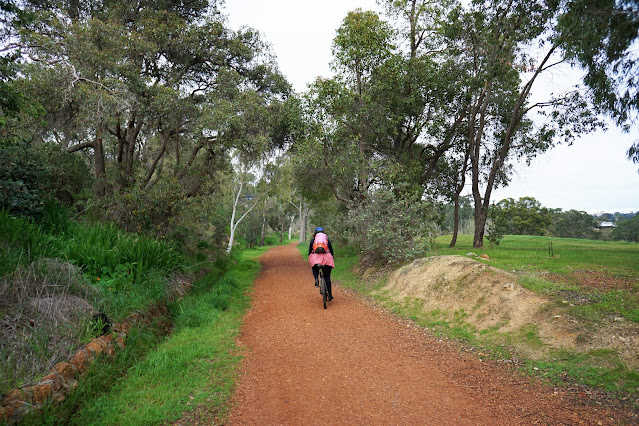



















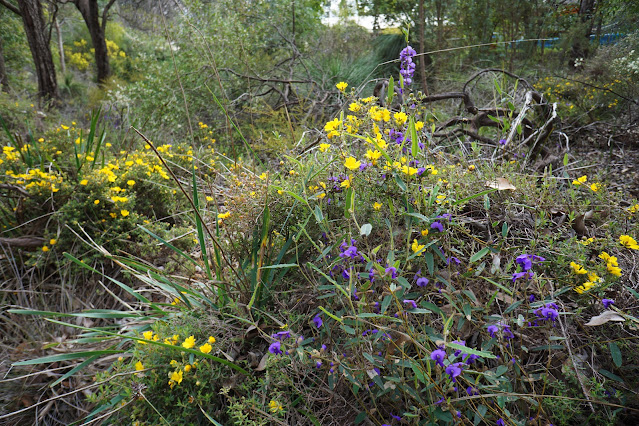









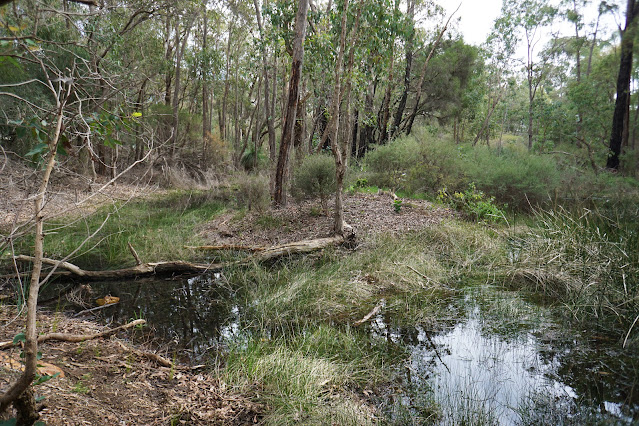




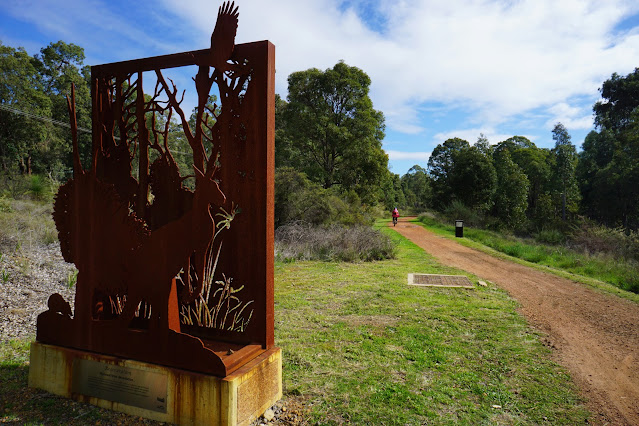










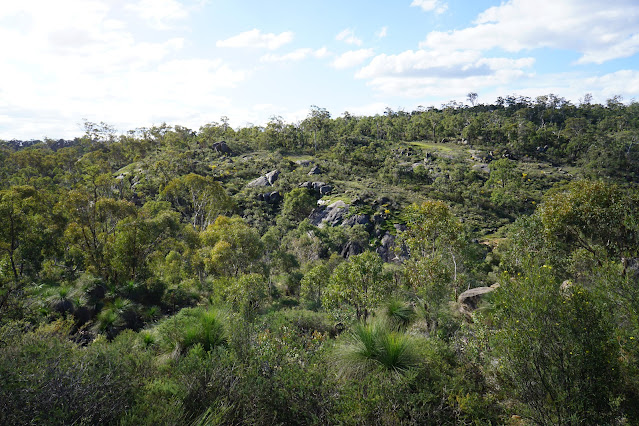












0 comments:
Post a Comment